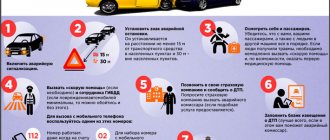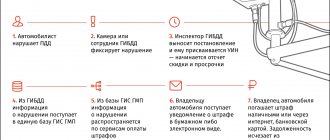In order to properly sue the person responsible for the accident for compensation for damages and not be afraid of the application being rejected, first of all, you will need to competently draw up a claim. Additionally, the necessary documentation must be prepared to prove the defendant’s guilt and certify the need to pay compensation. The court will accept the request only if there are grounds, which may include the absence of a compulsory motor liability insurance policy from the culprit, the inability of the insurance company to compensate for the damage in full, and other cases.
When is it worth filing a lawsuit against the person responsible for the accident?
First of all, the victim must understand that it is not always possible to file a claim against the driver who is guilty of an accident on the road. That is, of course, it is not forbidden to go to court, but the case may not proceed due to the lack of worthy grounds.
First, it’s worth finding out whether the culprit has valid MTPL insurance, since it is this policy that covers both material and physical harm caused to the victim. If the offender is insured, the compensation payment is provided directly by his insurer after an examination.
It is worth taking into account the current insurance limits. Currently, the maximum payment amount under a car insurance policy is:
- 400 thousand rubles for cases where only the property of citizens was damaged, in particular, vehicles;
- 500 thousand rubles if harm was caused to human health, and the degree of such harm is characterized as moderate or severe.
If the calculation of the cost of damage shows that the insured amount is sufficient to compensate for losses, the victim receives payments either in cash or in kind (repair work to eliminate damage to the car). But if the damage exceeds the limit provided for by the MTPL policy, the culprit must make up for the lack of funds. According to paragraph 1079 of the Civil Code of the Russian Federation, the violator is obliged to pay compensation to the injured citizen in full . This fact is also confirmed by Article 1064 on the general grounds for compensation for harm.
And this is where it may be necessary to go to court, since it is not always possible to reach an agreement with the violator peacefully. In most cases, car owners who are at fault for an accident prefer to evade the obligation to compensate the victim for harm. Accordingly, the remaining amount of compensation can only be claimed through the court. This applies to both road accidents that resulted in damage to the car, and accidents in which the health of citizens was damaged.
It is also possible to file a claim under the following circumstances:
- the culprit does not have mandatory insurance or the policy period has expired and the car owner has not yet renewed it (a fake policy is also invalid);
- if there are three or more victims (as a rule, in this case there is not enough insurance and each of the victims has the right to recover the missing amount through the court);
- if harm has been caused to a citizen’s health and the amount of the insurance limit is not able to cover it (treatment and medical services are compensated);
- the victim was performing work duties (you can request compensation for benefits lost during an accident in the form of income);
- the damage to the car was not caused while driving, for example, the car was scratched in the parking lot when the doors were opened (such damage is not included in the list of insured events, so the damage is recovered directly from the culprit);
- the insurance company went bankrupt or was liquidated;
- the insurer refused to provide compensation or underestimated the cost of damage (the claim is filed against the insurance office).
Another case where the victim has the absolute right to appeal to the courts is compensation for moral damage . For example, if a close relative died in an accident or the victim received an injury that precludes further work or causes constant pain. This also includes insults, threats, and pressure from the perpetrator against the victim.
The Supreme Court clarified what circumstances are subject to proof in disputes regarding the recovery of damages for an accident
The Judicial Collegium for Civil Cases of the Supreme Court issued Ruling No. 66-KG20-3 in a dispute over the recovery of damages by the owner of a car damaged in an accident from the culprit.
In September 2021, an accident involving three cars occurred in Irkutsk, for which one of the drivers, Mikhail Smirnov, was found guilty. Subsequently, the owner of one of the damaged cars, Anastasia Nagorskaya, turned to the insurance company for direct compensation for losses, but she was denied this due to the absence of a compulsory motor liability insurance policy from the person responsible for the accident. In this regard, the woman filed a claim against Mikhail Smirnov for damages in excess of 515 thousand rubles, and expenses for conducting an examination in the amount of 18 thousand rubles. and the state duty paid is more than 11 thousand rubles.
The court refused both to satisfy the claim and to recover the costs of compiling a review of the expert’s opinion. At the same time, he proceeded from the fact that Mikhail Smirnov’s guilt in committing the accident was not confirmed in the case materials. Subsequently, this court decision survived the appeal, which considered, citing the expert opinion of the PROF-EXPERT society dated January 8, 2021, that it was the plaintiff, not the defendant, who was to blame for the accident.
In a cassation appeal to the Supreme Court, Anastasia Nagorskaya appealed against judicial acts as illegal.
After studying the materials of the case, the Judicial Collegium for Civil Cases of the Armed Forces of the Russian Federation, with reference to Art. 86 and 87 of the Code of Civil Procedure of the Russian Federation recalled that the expert’s conclusion must contain a detailed description of the research conducted, the conclusions drawn as a result and answers to the questions posed by the court. In cases of insufficient clarity or incompleteness of the expert opinion, the court may order an additional examination, entrusting it to the same or another expert.
As the Board explained, in the case under consideration, the representative of Anastasia Nagorskaya petitioned for a re-examination, citing the inadmissibility of the expert’s conclusion from the PROF-EXPERT company in connection with the significant violations committed during its implementation, as well as the contradictions therein. Nevertheless, the court of first instance refused to satisfy such a petition, but did not evaluate the arguments of the plaintiff’s representative about the shortcomings of the expert’s opinion and the violations committed by him in violation of Art. 198 Code of Civil Procedure of the Russian Federation.
Moreover, from the circumstances established by the court, it followed that the collision of two cars belonging to the participants in the dispute occurred as a result of the car driven by the defendant changing lanes into the right lane, in which the car driven by Nagorskaya was moving. At the time of the collision, Smirnov’s lane change maneuver had not been completed.
“In denying the claim, the courts referred to the expert’s conclusion that Anastasia Nagorskaya exceeded the permissible speed limit, and if she had moved at the permitted speed, she would have been able to prevent a collision between cars. However, the courts did not take into account that, by virtue of paragraph 2 of Art. 1064 of the Civil Code of the Russian Federation, the obligation to prove the absence of guilt is assigned to the tortfeasor, and by virtue of clause 8.4 of the Traffic Rules, approved by Resolution of the Council of Ministers - Government of the Russian Federation of October 23, 1993 No. 1090, when changing lanes, the driver must give way to vehicles moving in the same direction without changes in direction of movement. Refusing to satisfy the claim for compensation for damage in full on the grounds of Anastasia Nagorskaya’s fault in the traffic accident, the courts did not take into account the provisions of Art. 1083 of the Civil Code of the Russian Federation, according to which damage caused by the intent of the victim is not subject to compensation,” the Supreme Court noted.
The Supreme Court added that if there is a fault on the part of the tortfeasor, the basis for refusing the claim is the intent of the victim, and for reducing the amount of compensation - the gross negligence of the victim (with the exception of compensation for certain expenses specified in the law). However, the lower authorities did not draw conclusions about the proof of Smirnov’s innocence or the proof of Nagorskaya’s intent. In this regard, the Supreme Court overturned the ruling of the appeal and returned the case to her for a new consideration.
Ilya Prokofiev, lawyer for MCA Centryurservice, noted that the courts of first and appellate instances, while refusing to satisfy the plaintiff’s demands, did not actually establish the circumstances that were significant for the case, and did not take into account that the defendant’s guilt in the accident was established by the traffic police, and were guided solely by the expert’s opinion presented at the court hearing. “At the same time, the courts formally approached the consideration of the plaintiff’s request to conduct a re-examination in connection with the violations committed and disagreement with the expert’s conclusions. This approach does not correspond to the principles of comprehensiveness, completeness and objectivity of consideration of the case, which, of course, could not go unnoticed by the Supreme Court,” he believes.
According to the lawyer, by canceling judicial decisions and sending the case for a new trial, the Supreme Court pointed out the need for a full and comprehensive consideration of the case in order to establish the circumstances that must be established in this category of cases, namely: the degree of guilt of each of the participants in the accident or the lack thereof. “This position is generally consistent with judicial practice, but also complements it, since courts often base the court decision on the initial administrative material compiled by the traffic police officers, in which the culprit of the accident is identified, and based on the conclusions set out in this material, they make a decision on business. The position of the Supreme Court may change the practice of prejudicial significance of administrative material of the traffic police authorities for this category of disputes,” suggested Ilya Prokofiev.
Igor Ershov, head of the arbitration practice of Khalimon and Partners Law Firm, noted that establishing the elements of a civil offense, including the guilt of the offender, requires carefulness and accuracy on the part of the participants in the process and the court: “However, this determination of the Supreme Court is not limited only to the direct question of a person’s guilt in committing an accident, since the Judicial Collegium for Civil Cases of the Supreme Court simultaneously identifies several problems and issues that are interesting in themselves.”
According to the expert, firstly, in the case under consideration, the problem of the relationship between imperative norms arises. “On the one hand, the law obliges the driver to give way to vehicles moving in the same direction without changing the direction of travel, but, on the other hand, drivers are required to comply with the speed limit. Obviously, these mandatory norms create a contradiction that significantly affects the determination of the guilt of the harm-doer and the guilt of the victim in unlawful actions. Secondly, the Supreme Court emphasizes, in development of the provisions of the law, that an expert opinion is not necessary for the court and it is not the exclusive means of proof. Consequently, the courts were asked to establish a certain balance between the expert opinion and the provisions of regulatory legal acts, eliminating the contradiction between them,” explained Igor Ershov.
He added that the courts must make conclusions not only about the proof of the guilt/innocence of the harm-doer, but also about the proof of the intent or gross negligence of the victim. “Thus, the Supreme Court, having considered the particular case of compensation for losses caused by an accident, makes broader conclusions that can affect not only cases of compensation for losses, but also other categories of disputes,” the expert concluded.
Which court should I go to?
Filing a claim for compensation for damage, material, physical or moral, is submitted to the court at the place of registration of the guilty person. If the price of the application is less than 50 thousand rubles, the application is transferred to the justices of the peace. Otherwise, you must visit the district court.
The processing time for cases involving minor amounts takes no more than 30 days. If the price of the claim exceeds 50 thousand rubles, the period of proceedings may be 2 months or more. Do not forget that such issues have a statute of limitations - a claim should be filed within 3 years after the accident occurred, but no later.
Situations in which the person responsible for the accident can sue the victim
In judicial practice, there are cases when the culprit of an accident files a claim against the injured driver.
These include:
- unfair assignment of guilt in an accident, emergence of new evidence;
- deception on the part of the victim;
- damage to the culprit’s vehicle as a result of unlawful actions of the injured driver;
- causing bodily harm to the culprit or his passengers.
Each situation is considered individually. But before going to court, you should consult with a lawyer or lawyer, so it is advisable to open a case in a specific case.
After an accident, the injured party can recover monetary compensation from the person at fault in certain cases. And in order to achieve a positive result, you should approach the issue legally competently.
It is important to complete the application correctly and attach the necessary documents. Only if the rules are followed will it be possible to receive the amount of money due.
Preparing to file a claim
Regardless of the case and the reasons on the basis of which compensation is supposed to be collected, filing a lawsuit against the culprit of the accident for compensation for damage requires preliminary action. First of all, it is important to try to resolve the issue amicably by sending a written complaint to the culprit. The paper must indicate the amount of compensation and the time frame for its payment.
If the culprit expresses disagreement, you should take a corresponding receipt from him. According to the rules, the launch of a judicial procedure occurs only after confirmation of the fact that attempts to resolve the issue peacefully took place.
Before going directly to court, you need to make sure that the accident was properly documented. If there is no evidence that the accident occurred at all (documents, protocol, certificates), the claim will be rejected. You will also need to collect other documents, the list of which will depend on the grounds of the claim. Additionally, an independent assessment of losses is carried out. For this purpose, you can use the services of private specialists, but only upon presentation of the appropriate permission and license to operate on their part. Based on the results of the procedure, a conclusion is drawn up, which is signed by the expert.
If you need compensation for health damage, you should make sure you have the following documents:
- certificates from medical institutions;
- receipts proving expenses for treatment, operations, medications and rehabilitation measures;
- a certificate from the place of employment about the amount of income, if as a result of an accident the person lost part of his salary;
- an extract from the card proving the fact of prescription of medications and procedures.
In addition, it is recommended to undergo additional medical examination in order to provide an expert doctor's opinion in court. In a word, the preparatory stage includes the collection of evidence.
How to compensate for damages from the culprit of a traffic accident
If an agreement on voluntary payment of your expenses due to an accident could not be reached, there are two methods of forced collection:
- pre-trial claim. The method under consideration involves drawing up a written demand for repayment of the monetary costs incurred by the injured party.
- filing a claim in court.
If, as a result of an accident, a person is injured, resulting in serious harm or death, the perpetrator bears criminal liability. In addition to the punishment under the Criminal Code of the Russian Federation, which will be determined by a court of general jurisdiction, a civil claim can also be filed within the criminal process without addressing this issue separately.
The court is obliged to indicate in the verdict the fate of the claim:
- leave it without consideration, recognizing the right to apply in a civil manner (this outcome often awaits those who have not sufficiently substantiated the size of their claims);
- satisfy (if all evidence is presented that confirms the value of the claim);
- refuse satisfaction (in practice, this happens, for example, when the plaintiff has previously received certain compensation and has again addressed the same issue during the consideration of a criminal case).
We suggest you read: How to renew a lease agreement for non-residential premises
The victim can file not only financial claims, but also compensation for damage to health. At the same time, there is no need to pay state fees for such disputes (in terms of compensation for damage to health).
To do this, it is enough to present to the court medical documents confirming the duration of treatment, diagnosis, need for rehabilitation, as well as a doctor’s opinion on the consequences of injury, mutilation, etc. In addition, this data may be contained in protocols drawn up by traffic police officers, decisions made by a magistrate.
The practice of compensating people for harm resulting from accidents varies across regions.
Thus, for the death of a victim in an accident, they can determine payment from one to three million rubles, for various degrees of injury - from one hundred thousand to one and a half million rubles. A claim in a criminal case cannot be satisfied if the person who committed the accident is acquitted.
Contents of the claim
The default starting point in court cases is the statement of claim. It is allowed to draw up the paper in free form, however, the content of the claim must clearly reflect the essence of the request, as well as additional facts.
The following information will need to be covered:
- full name of the court;
- information about the plaintiff and defendant (address information, full name, contacts);
- a detailed but not vague description of the circumstances of the accident, as well as the resulting harm;
- a list of factors indicating the defendant’s guilt;
- claims and claims of the plaintiff against the culprit of the accident;
- amount of compensation and its detailed calculation;
- an indication of the fact that there were attempts to pre-trial resolve the problem, which did not lead to positive results;
- list of attachments - documents, protocol, certificates and other papers;
- date of document preparation;
- signature of the victim.
The text of the claim should not be overly emotional or include colloquial expressions. Information should be presented strictly on the merits of the issue.
statement of claim against the culprit of the accident
Lawsuit: types, differences
To understand the procedure, let's consider the situation in detail.
When purchasing a car, you take out a mandatory MTPL policy. The motorist thinks that there will be no need to pay for the damage themselves if he becomes the culprit of the accident. Insurers, having paid the amounts to the injured party, try to compensate the costs at the expense of the culprit. Claims can be filed in two ways:
- by way of subrogation: the victim’s insurance company demands that the culprit pay the difference between the limit on compulsory motor liability insurance (400,000 rubles) and the actual costs of repairs. The limitation period of 3 years is counted from the moment of the accident;
- through a regressive claim: the own insurance company tries to reimburse the victim’s expenses incurred. Presented in cases recognized as non-insurance (absence of a compulsory motor liability insurance policy, driver’s license, etc.). The same statute of limitations begins from the moment the company makes payments.
It is important to determine what requirements are presented in order to properly build a line of defense. In most cases, it is possible to change the original amount claimed.
Documentation
The documentation package for filing a claim must contain the following documents (it is better if these are copies, but you should have the original documents with you, as well as at the court hearing):
- the application itself (in the number of samples equal to how many people will take part in the process);
- act on the occurrence of an insured event (requested from the insurance office);
- certificate of accident from the traffic police;
- a protocol drawn up by traffic police officers in the case of an administrative violation, as well as on the inspection of the accident scene;
- notice of call not inspection;
- opinion of an independent expert regarding the amount of damage;
- papers from the insurance office, for example, a refusal to pay, a document on the amount of compensation paid;
- payment documentation indicating expenses incurred as a result of an accident (including expenses for treatment, if we are talking about harm to health);
- receipt of payment of the duty (at least 800 rubles).
Documentation and the claim may be submitted to the court office in person. In this case, you must have a copy of the application with you, on which the responsible employee will mark the acceptance of the papers. It is also possible to send the package by valuable mail. Another option is the services of a trusted person, who will generally carry out all actions for the injured citizen.
Collection of compensation from the culprit of a transport accident by applying to the judicial authorities is allowed only in a number of cases. In this case, the victim will need to prepare evidence of the fact that the damage was not covered and that an accident occurred at all. Typically, the consideration of cases on such claims is completed with a positive result, and compensation is paid to the victim in full or in part of the amount that he requested.
What do you need to prepare from documents?
When you first go to court, you will need two main documents: the injured driver’s civil passport and a statement of claim.
When considering the case you will need to provide:
- accident scene inspection report;
- investigative reports;
- materials collected from the scene of the incident;
- documents from the insurance company;
- witness statements.
In cases where people were injured in an accident, the court will request documents from the forensic medical examiner.
The list of documents depends on the specific case. The list can be clarified by a court representative, traffic police officers or an investigator.
The statement of claim is the main document reflecting the essence of the application to the court. It must be drawn up correctly, without errors or blots.
Where to file a claim
The statement of claim along with a package of documents should be submitted at the place of registration of the person responsible for the accident. If the amount of the claim is less than 50 thousand rubles, the application is submitted to the magistrate court; if it is more, then the case will be considered in the district court.
Before your documents are accepted in court, do not forget to pay the state fee. The magistrate must consider your case within 30 days from the date you submit your application; for other courts this period is 60 days.










